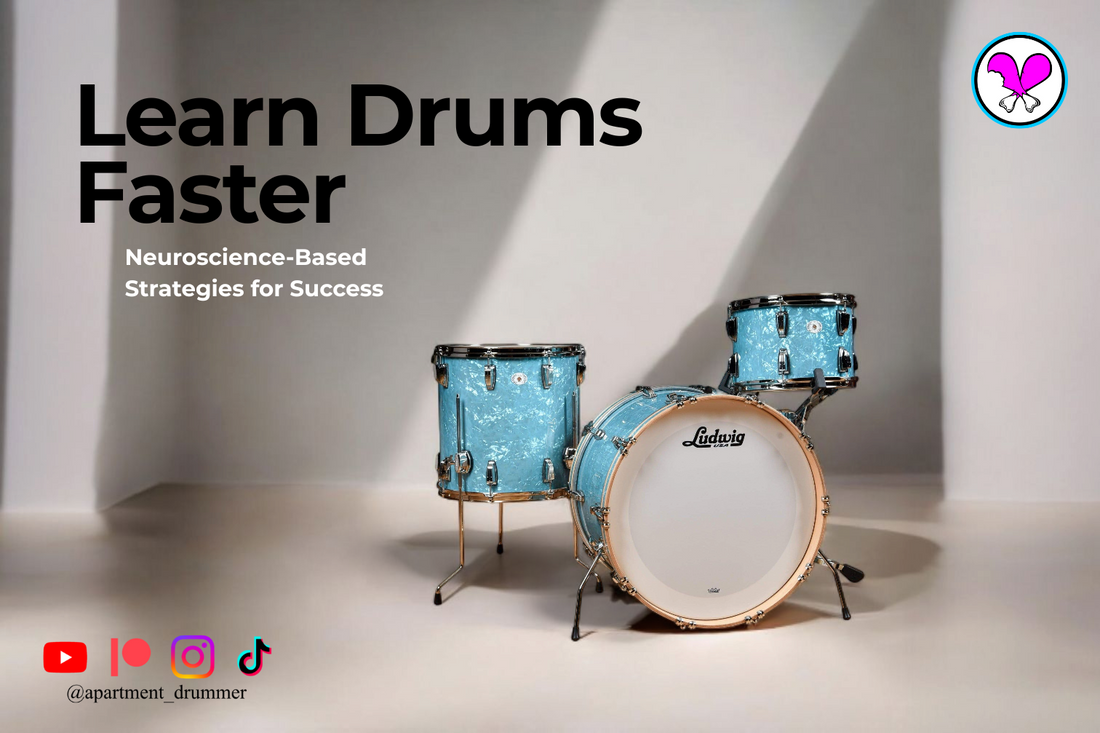
The Fastest Way to Learn Drums: A Neuroscience-Based Strategy
Share
Learning the drums can feel overwhelming, especially when you see seasoned drummers playing effortlessly. But what if there was a scientifically proven way to learn drums faster and more effectively? As a drummer with a background in neuroscience and psychology, I’ve studied how the brain learns and remembers best — and I’ll be sharing a few critical practice strategies to significantly boost your drumming progress.
How Your Brain Learns Drums (The Science Behind It)
Your brain is constantly forming and fine-tuning neural connections when you practice an instrument. The stronger and faster these connections form, the better you become. Here’s a brief overview of how to hack your brain’s learning process for better results:
- Start with Goals: A Structured Learning Path - Random practice not only slows progress but can also kill motivation. Without a clear roadmap, your brain struggles to make meaningful connections, leading to frustration and stagnation. Instead, follow a step-by-step system that ensures steady improvement:
· Beginners: Start with fundamental rhythms (eg. 8th note beat variations), basic stick control, and reading simple drum sheet music.
· Intermediate Drummers: Focus on groove development, speed, improving timing with a metronome, and learning essential drum fills.
· Advanced Players: Challenge yourself with dynamic control, polyrhythms, and mastering complex song structures.
💡 Get access to structured drum lessons that take the guesswork out of your practice routine here! 💡
- Spaced Repetition – Practicing in short, frequent sessions helps your brain form stronger neural connections compared to long, infrequent sessions. This technique works because your brain requires repeated exposure over time to reinforce and strengthen newly learned skills. When you practice, your brain encodes new drumming patterns by building and strengthening neural pathways. However, maintaining these pathways requires significant biological resources (e.g., protein synthesis and neurotransmitter production). If you overload your brain with too much information in a single session, it struggles to retain it all. Here’s how spaced repetition helps:
· ✅ Boosts Retention: Your brain consolidates skills during rest periods, making short, frequent practice more effective than marathon sessions.
· ✅ Prevents Burnout: Practicing for hours at once leads to mental fatigue, decreasing efficiency and motivation.
· ✅ Enhances Motor Learning: Skills solidify during sleep, so practicing multiple times a day followed by rest leads to faster, more permanent learning.
- Multisensory Learning – Your brain absorbs information more effectively when multiple senses are engaged simultaneously. This is why reading drum notation, listening to rhythms, and physically playing beats together lead to deeper learning. Try implementing the following strategies into your practice for improved learning outcomes:
· 👁️ Visual Learning: Reading drum sheet music creates a mental map of beats, helping you recognize patterns faster and learn new beats/fills quickly.
· 👂 Auditory Learning: Developing ear-training skills by listening to isolated drum parts and drumless tracks sharpens rhythmic perception.
· 💪 Kinesthetic Learning: The physical act of drumming strengthens muscle memory, making beats feel natural over time.
🎼 Browse interactive drum sheet music with enhanced, isolated and drumless tracks to boost retention here.
- The “Chunking” Method to Learn Faster - Complex drum beats and fills can be intimidating, but chunking helps you learn them faster by breaking them down into small, manageable sections. Instead of attempting to play an entire groove or fill at once, divide it into logical rhythmic phrases and master each one individually before piecing them together.
· Step 1: Identify Chunks – Break the pattern into 2–4 beat sections.
· Step 2: Practice Each Chunk – Play one chunk slowly until it feels natural.
· Step 3: Combine Chunks – Link the chunks together, increasing speed gradually.
· Step 4: Play the Full Pattern – Once comfortable, play the full groove or fill in time.
- Error-Based Learning – Mistakes are not failures—they’re opportunities for stronger learning. Neuroscientific research shows that correcting errors builds stronger neural pathways than simply repeating something perfectly. The process of recognizing and fixing mistakes forces your brain to engage more deeply, leading to faster progress. Here are a few practical applications to implement into your drum practice for faster improvement:
· 🐌 Slow-motion correction – If a fill feels sloppy at full speed, reduce the tempo significantly and analyze your movements. Pinpoint where mistakes happen and refine each motion before gradually increasing speed.
· 👁️ Play a groove with your eyes closed (for visual learners) – This forces you to rely on alternative cues for memory recall. If you lose the beat, restart and adjust until you can play it consistently.
· 👂 Play a groove with a different auditory context (for those who learn by ear) – Similarly, this also forces you to rely on alternative cues for memory recall. If you’re used to playing a groove with a song, try playing it with the metronome or drumless track instead.
· 🎥 Mimic professional drummers – Mirroring the actions of other individuals is a deeply-engrained and effective method of learning. Record yourself playing along with a song, then compare your dynamics, timing, and phrasing to the original drummer. Adjust your timing/technique/dynamics based on discrepancies you notice.
- Slow & Fast Practice - Mastering any musical instrument, including the drums, relies heavily on developing muscle memory—the ability to perform movements automatically without conscious thought. Neuroscience shows that your brain best retains movement patterns when you practice slowly at first, allowing your neural pathways to form solid connections before increasing speed. Here’s a step-by-step method to effectively train your muscle memory:
· 1. Start at 50% speed – Focus on technique and precision.
· 2. Increase speed 5-10% at a time – Lock in the groove.
· 3. Push to 100% speed – Maintain accuracy.
· 4. Play beyond 100% speed – Over-speed training solidifies control and technique.
🎯 Ready to learn smarter? Don’t waste any more time with inefficient practice — let’s get you on the fast track to success. Explore some of the resources I've designed to help you practice more effectively:
✅ Drum Sheet Music & Play-Along Tracks – Learn faster with structured, interactive materials that make practicing fun and easy. [Start Learning]
✅ Silent Stomper Platforms – Enjoy quiet, focused practice sessions without disturbing your neighbors or compromising sound quality. [Shop Now]
✅ One-on-One Drum Lessons with Nicole – Got specific questions? Not sure where to start? Check out the list below for common lesson topics. Get personalized guidance tailored to your goals and skill level for fast, steady, and measurable progress. [Join Now]
- How to quickly learn songs from start to finish
- Simple tricks for reading drum sheet music & understanding rhythmic theory
- How to record drums at home for professional-quality sound
- Strategies for improving speed, dynamics, coordination, timing & more
